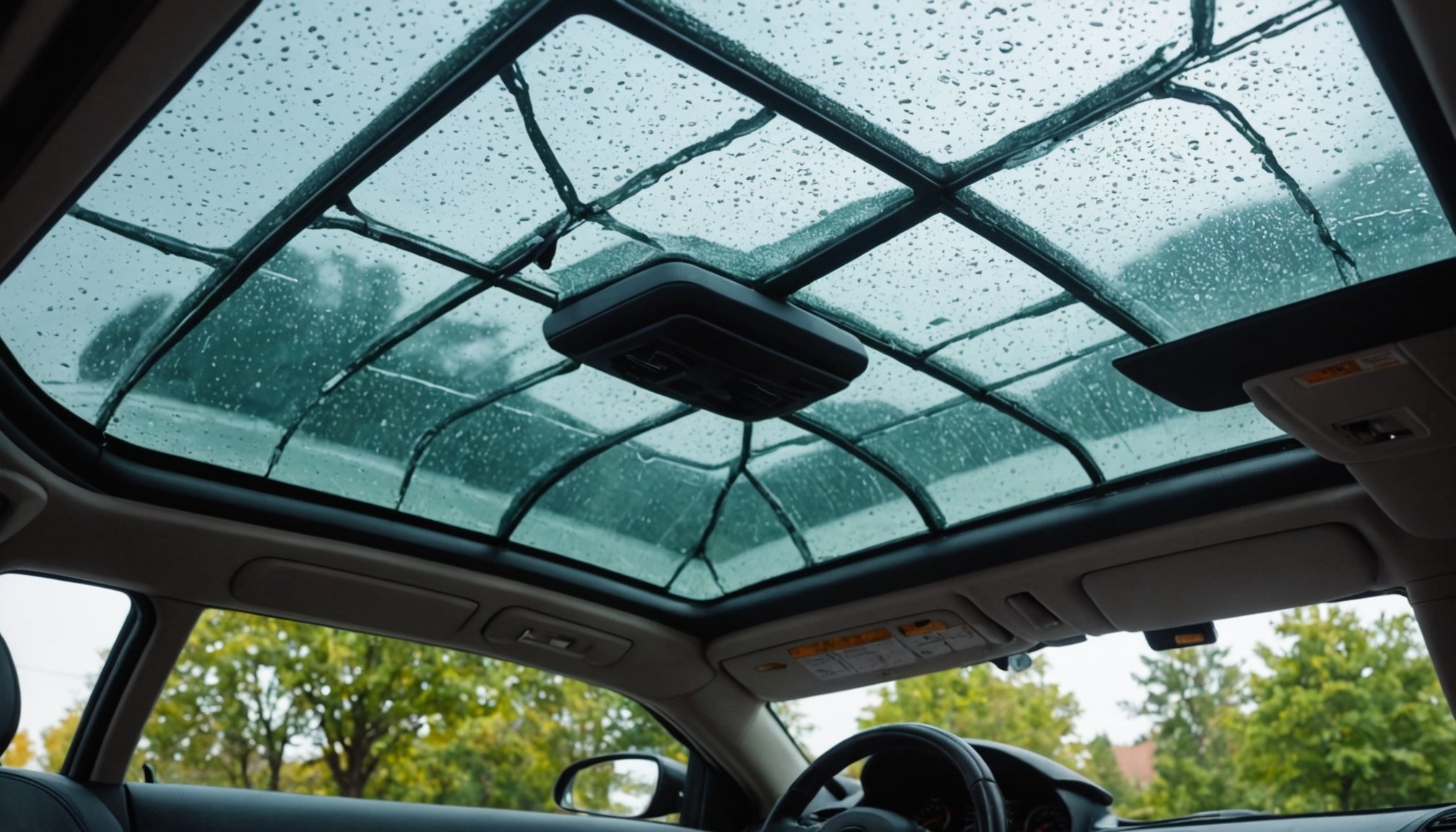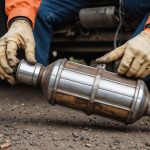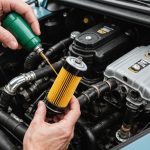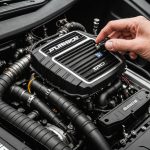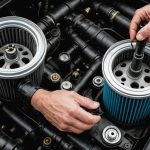Importance of Sunroof Maintenance
Proper sunroof maintenance is crucial in ensuring your vehicle remains leak-free. A neglected sunroof can lead to significant issues, including water damage that might impact the interior and electrical components. Regular maintenance for leak prevention is essential, as it helps identify potential blockages in drainage channels, which are common culprits for leaks. Pooled water around these channels during wet conditions is an initial sign that should not be ignored.
Delaying regular automotive care can exacerbate minor issues into more severe complications. For example, seals and gaskets around a sunroof can degrade over time, leading to inefficient sealing. Water damage isn’t just an inconvenience; it can result in mold growth, foul odours, and damage to upholstery. Moreover, electrical systems are particularly susceptible to moisture, causing malfunctions that might lead to costly repairs.
Have you seen this : Key signs that it’s time to replace your car’s catalytic converter
To sum up, ensuring regular maintenance for your sunroof not only preserves its functionality but also safeguards the larger integrity of your vehicle. Staying proactive with maintenance can prevent unexpected vehicle damage and keep repair costs at bay. Implementing simple checks and regular cleaning can be a small effort that pays off in the long term.
Regular Cleaning Techniques
Ensuring your sunroof remains in top condition begins with proper sunroof cleaning. Regular cleaning not only helps maintain appearance but also prevents costly repairs due to neglected dirt and debris. Dirt removal from the sunroof channels is crucial in preventing blockages that can lead to leaks. For effective cleaning, you’ll need a few recommended cleaning supplies: a soft-bristled brush, non-abrasive cleaner, and a microfiber cloth.
This might interest you : Ultimate diy guide: safely replace your suv”s serpentine belt in easy steps
Start by opening the sunroof to inspect the entire track. Use the soft-bristled brush to gently loosen and remove visible debris. Next, apply the non-abrasive cleaner to a microfiber cloth and wipe down the tracks, focusing on sections where the most grime accumulates. For channels prone to collecting water or dust, consider using a fine-tipped tool wrapped in the cloth to reach narrow sections.
Implementing these maintenance tips consistently will ensure debris buildup is kept at bay. It’s advisable to clean your sunroof every few months, especially after harsh weather or driving in dusty environments. Gently closing the sunroof after each cleaning session will help identify minor cleaning oversights or necessary adjustments before they become significant issues.
Inspection and Detection of Issues
Regular sunroof inspection is essential for maintaining its functionality and preventing leaks. Pay attention to key areas such as the seals and drainage channels. These components are often vulnerable to wear and can contribute to leaks if neglected. Regular checks help in proactive leak detection, identifying potential issues before they escalate.
To perform an effective inspection, start by visually examining the rubber seals for cracks or detachment. Feel for any moisture around the edges, which is an initial sign of a seal failure. Inspect the drainage channels for blockages; use a fine tool to clear any visible debris. If water pools along these channels, it can eventually seep into the vehicle.
Seasonal inspections are crucial as weather changes may affect the sunroof’s condition. For instance, cold weather can cause seals to contract, leading to gaps and potential leaks. Understanding these preventive measures helps in maintaining the sunroof’s integrity. Ensure that the inspection is thorough and includes testing the sunroof’s operation. By regularly checking for common fault areas, you can avoid major repair costs and prolong the lifespan of your sunroof.
Sealing Techniques for Leak Prevention
Ensuring effective sunroof sealing is indispensable for preventing leaks and keeping your car well-weatherproofed. Choosing the correct sealant type is critical. Silicone-based sealants are popular due to their flexibility and excellent adhesion properties. Some professionals might also recommend polyurethane for its durability and water resistance.
When resealing a leaking sunroof, follow these steps: First, gently clean the affected area to remove debris and old sealant. This ensures the new sealant adheres properly. Next, carefully apply the sealant evenly around the edges. It’s advisable to wait for a dry day to perform this task to avoid moisture exposure. Use a fine-tipped applicator for precision and smooth out any excess using a gloved finger or a smooth tool. Allow adequate drying time, usually specified on the product instructions.
To maintain a proper seal, inspect it regularly for any signs of wear or detachment. This proactive step helps in maintenance, mitigating potential leaks. Remember, periodic resealing is part of an overall maintenance strategy to extend the longevity of your sunroof and prevent water ingress that could cause major damage.
Troubleshooting Common Sunroof Issues
Navigating sunroof troubleshooting can save time and money by addressing problems before they escalate. One frequent issue is mechanical failure, where the sunroof may not open or close correctly. In such cases, check for obstructions in the tracks or inspect the motor functionality. If the problem persists, consider seeking professional assistance to avoid further damage.
Leak resolution is another common concern. Begin by examining the sunroof seals and drainage systems. If a blockage is detected, clear the debris immediately. This simple step often eliminates leaks. For persistent leaks, resealing might be necessary to ensure proper weatherproofing.
When contemplating repairs, gauge the complexity of the issue: minor blockages or debris can typically be managed with DIY methods, while mechanical or severe leakage problems might require professional intervention. Tailor your approach based on the severity of the problem—this enhances efficiency and reduces unnecessary risks.
Post-repair, adopting preventive measures such as regular inspections and cleaning ensures these issues remain at bay. Additionally, understanding sunroof mechanics allows for more effective troubleshooting in the future, extending its lifespan and reliability.
Enhancing Sunroof Longevity
Proper sunroof longevity relies on implementing consistent care tips and comprehensive vehicle maintenance. To achieve this, there are additional practices that owners should adopt. Ensuring the seals remain flexible by applying a silicone-based lubricant can significantly reduce wear over time. Lubrication minimizes friction and extends the functionality of the moving parts, preventing potential sticking or mechanical failure.
Another important aspect is being mindful of environmental factors that might impact the sunroof. Prolonged exposure to harsh weather conditions, such as intense sunlight or freezing temperatures, can degrade materials. To counteract this, park the vehicle in shaded areas or use a protective cover during extreme weather.
Recommended practices also vary based on seasons. Regular checks and lubrication during fall can prevent debris blockage from fallen leaves, while winterization processes ensure seals remain pliant in colder temperatures. Routine checks in spring help address any damage accrued over harsher months. By adopting these tailored approaches, sunroof integrity is preserved, functionality is prolonged, and the risk of costly repairs is minimized, contributing to the overall longevity of the sunroof.

